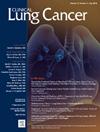Real-World Efficacy and Safety of Durvalumab Administration Following Chemoradiotherapy in Elderly Patients With Unresectable Locally Advanced Nonsmall Cell Lung Cancer: A Multicenter, Retrospective Study
IF 3.3
3区 医学
Q2 ONCOLOGY
引用次数: 0
Abstract
Background
The PACIFIC trial established durvalumab administration after chemoradiotherapy as the standard of care for unresectable locally advanced nonsmall cell lung cancer (LA-NSCLC). However, the efficacy and safety of durvalumab in elderly patients aged 75 years or above remains unclear. This study aimed to investigate the real-world efficacy and safety of durvalumab for LA-NSCLC, with a specific focus on elderly patients.
Patients and Methods
We reviewed 214 patients who received durvalumab out of 278 patients with unresectable LA-NSCLC who underwent chemoradiotherapy at 7 institutions between July 2018 and March 2022. Propensity score matching (PSM) analysis was performed to evaluate the efficacy of durvalumab in elderly patients.
Results
The 2-year progression-free survival (PFS) and 2-year overall survival (OS) rates were 42.2% (95% confidence interval [CI], 34.7%-49.5%) and 77.1% (95% CI, 70.1-82.7%), respectively. Grade ≥ 3 immune-related adverse events (irAEs) occurred in 8.2% of patients. PSM analysis revealed that OS was significantly shorter in elderly patients (≥ 75 years) than in younger patients (< 75 years) (hazard ratio [HR]; 95% CI, 1.39-8.99; P = .008), whereas PFS did not differ significantly between the 2 groups (HR: 1.50, 95% CI, 0.84-2.68, P = .169). The frequency of irAEs did not differ between these groups.
Conclusions
The real-world efficacy and safety of durvalumab administration following chemoradiotherapy for LA-NSCLC coincided with the PACIFIC trial's findings. Disease control achieved with this protocol did not differ significantly between elderly and younger patients but had acceptable tolerability, demonstrating its benefit even in elderly LA-NSCLC patients aged 75 years or above.
化疗后服用 Durvalumab 对不可切除的局部晚期非小细胞肺癌老年患者的实际疗效和安全性:一项多中心回顾性研究
背景PACIFIC试验将化放疗后服用度伐单抗确立为治疗不可切除的局部晚期非小细胞肺癌(LA-NSCLC)的标准疗法。然而,在75岁或以上的老年患者中,度伐卢单抗的疗效和安全性仍不明确。本研究旨在调查durvalumab治疗LA-NSCLC的实际疗效和安全性,特别关注老年患者。患者和方法我们回顾了2018年7月至2022年3月期间在7家机构接受化放疗的278例不可切除LA-NSCLC患者中接受durvalumab治疗的214例患者。结果 2年无进展生存期(PFS)和2年总生存期(OS)分别为42.2%(95%置信区间[CI],34.7%-49.5%)和77.1%(95% CI,70.1-82.7%)。8.2%的患者发生了≥3级免疫相关不良事件(irAEs)。PSM分析显示,老年患者(≥75岁)的OS明显短于年轻患者(< 75岁)(危险比[HR];95% CI,1.39-8.99;P = .008),而两组患者的PFS无明显差异(HR:1.50,95% CI,0.84-2.68,P = .169)。结论 LA-NSCLC化疗后使用durvalumab的实际疗效和安全性与PACIFIC试验的结果一致。老年患者和年轻患者在使用该方案控制疾病方面没有显著差异,但耐受性可以接受,这表明即使是75岁或以上的老年LA-NSCLC患者也能从中获益。
本文章由计算机程序翻译,如有差异,请以英文原文为准。
求助全文
约1分钟内获得全文
求助全文
来源期刊

Clinical lung cancer
医学-肿瘤学
CiteScore
7.00
自引率
2.80%
发文量
159
审稿时长
24 days
期刊介绍:
Clinical Lung Cancer is a peer-reviewed bimonthly journal that publishes original articles describing various aspects of clinical and translational research of lung cancer. Clinical Lung Cancer is devoted to articles on detection, diagnosis, prevention, and treatment of lung cancer. The main emphasis is on recent scientific developments in all areas related to lung cancer. Specific areas of interest include clinical research and mechanistic approaches; drug sensitivity and resistance; gene and antisense therapy; pathology, markers, and prognostic indicators; chemoprevention strategies; multimodality therapy; and integration of various approaches.
 求助内容:
求助内容: 应助结果提醒方式:
应助结果提醒方式:


